Does Car Sharing Contribute to Urban Sustainability from User-Motivation Perspectives?
Abstract
1. Introduction
2. Literature Analysis
2.1. Role of Car Sharing in Urban Sustainability
2.2. Car Sharing Users—Motivation Factors
3. Research Methodology
- H-1: Car sharing is mostly used by younger and male consumers;
- H-2: Environmental benefits are the most significant factors influencing the choice of car-sharing services and should be considered by shared mobility service providers to ensure upscaling of car sharing;
- H-3: Economic benefits are the most significant factors influencing the choice of car-sharing services and should be considered by shared mobility service providers to ensure upscaling of car sharing in Latvia.
- The socio-demographic profile of respondents;
- The experience with the car-sharing services and usage patterns;
- Motivational factors influencing the choice of car-sharing services.
4. Research Results and Discussion
5. Conclusions
Author Contributions
Funding
Institutional Review Board Statement
Informed Consent Statement
Data Availability Statement
Acknowledgments
Conflicts of Interest
References
- United Nations. The New Urban Agenda; United Nations: Rome, Italy, 2017; ISBN 978-92-1-132731-1. [Google Scholar]
- European Commission. Report from the Commission to the Council on the Urban Agenda for the EU; COM 2017 657 Final; European Commission: Brussel, Belgium, 2017. [Google Scholar]
- European Environment Agency. Resource Efficiency and Low Carbon Economy—Transport Greenhouse Gas Emissions. Environmental Indicator Report. 2018. Available online: https://www.eea.europa.eu/airs/2018/resource-efficiency-and-low-carbon-economy (accessed on 24 March 2021).
- European Environment Agency. Greenhouse Gas Emissions from Transport, Indicator Assessment. Data and Maps. 2020. Available online: https://www.eea.europa.eu/data-and-maps/indicators/transport-emissions-of-greenhouse-gases-7/assessment (accessed on 24 March 2021).
- European Environment Agency. Passenger and Freight Transport Demand, Indicator Assessment. Data and Maps. 2019. Available online: https://www.eea.europa.eu/data-and-maps/indicators/passenger-and-freight-transport-demand/assessment (accessed on 24 March 2021).
- Bardhi, F.; Eckhardt, G.M. Access-based consumption: The case of car sharing. J. Consum. Res. 2012, 39, 881–898. [Google Scholar] [CrossRef]
- Ramanathan, S.; McGill, A.L. Consuming with others: Social influences on moment-to-moment and retrospective evaluations of an experience. J. Consum. Res. 2007, 34, 506–524. [Google Scholar] [CrossRef]
- Martin, C.J. The sharing economy: A pathway to sustainability or a nightmarish form of neoliberal capitalism? Ecol. Econ. 2016, 121, 149–159. [Google Scholar] [CrossRef]
- Bellotti, V.; Ambard, A.; Turner, D.; Gossmann, C.; Demkova, K.; Carroll, J.M. A muddle of models of motivation for using peer-to-peer economy systems. In Proceedings of the 33rd Annual ACM Conference on Human Factors in Computing Systems, Seoul, Korea, 18–23 April 2015; pp. 1085–1094. [Google Scholar] [CrossRef]
- Cook, K.S.; Cheshire, C.; Rice, E.R.; Nakagawa, S. Social exchange theory. In Handbook of Social Psychology; Springer: Dordrecht, The Netherlands, 2013; pp. 61–88. [Google Scholar]
- Homans, G.C. Social behavior as exchange. Am. J. Sociol. 1958, 63, 597–606. [Google Scholar] [CrossRef]
- Uvarova, I.; Platonova, I.; Rascevska, Z.; Volkova, T.; Atstaja, D. The value co-creation in circular business models: Quadruplex Helix perspective. In Proceedings of the 6th International Conference on New Business Models: New Business Models in a Decade of Action: Sustainable, Evidence-Based, Impactful, Halmstad, Sweden, 9–11 June 2021; Hoveskog, M., Halila, F., Eds.; pp. 382–389, ISBN 978-91-88749-68-0. [Google Scholar]
- Haboucha, C.J.; Ishaq, R.; Shiftan, Y. User preferences regarding autonomous vehicles. Transp. Res. Part C Emerg. Technol. 2017, 78, 37–49. [Google Scholar] [CrossRef]
- Iacobucci, R.; Bruno, R.; Schmöcker, J.-D. An Integrated Optimisation-Simulation Framework for Scalable Smart Charging and Relocation of Shared Autonomous Electric Vehicles. Energies 2021, 14, 3633. [Google Scholar] [CrossRef]
- Cocca, M.; Giordano, D.; Mellia, M.; Vassio, L. Free floating electric car sharing design: Data driven optimization. Pervasive Mob. Comput. 2019, 55, 59–75. [Google Scholar] [CrossRef]
- Boldrini, C.; Bruno, R.; Conti, M. Characterising demand and usage patterns in a large station-based car sharing system. In Proceedings of the 2016 IEEE Conference on Computer Communications Workshops (INFOCOM WKSHPS), San Francisco, CA, USA, 10–14 April 2016; pp. 572–577. [Google Scholar] [CrossRef]
- Clemente, M.; Fanti, M.P.; Mangini, A.M.; Ukovich, W. The Vehicle Relocation Problem in Car Sharing Systems: Modeling and Simulation in a petri net framework. In Application and Theory of Petri Nets and Concurrency, Proceedings of the PETRI NETS 2013, Milan, Italy, 24–28 June 2013; Lecture Notes in Computer Science; Colom, J.M., Desel, J., Eds.; Springer: Berlin/Heidelberg, Germany, 2013; Volume 7927. [Google Scholar] [CrossRef]
- Luo, K.; Erlebach, T.; Xu, Y. Car-Sharing on a Star Network: On-Line Scheduling with k Servers. In Proceedings of the 36th International Symposium on Theoretical Aspects of Computer Science (STACS), Berlin, Germany, 13–16 March 2019; Niedermeier, R., Paul, C., Eds.; Leibniz-Zentrum für Informatik, Dagstuhl Publishing: Wadern, Germany; Volume 51, pp. 1–14. [Google Scholar] [CrossRef]
- Esposito, M.; Tse, T.; Soufani, K. The circular economy: An opportunity for renewal, growth, and stability. Thunderbird Int. Bus. Rev. 2018, 60, 725–728. [Google Scholar] [CrossRef]
- Zhang, R.; Zhang, J. Long-term pathways to deep decarbonization of the transport sector in the post-COVID world. Transp. Policy 2021, 110, 28–36. [Google Scholar] [CrossRef]
- Mao, Z.; Zhang, W.; Yang, B.; Zhang, T. Impact of coronavirus pandemic on sharing mode of manufacturer. Comput. Ind. Eng. 2021, 158, 107386. [Google Scholar] [CrossRef]
- Curtale, R.; Liao, F.; van der Waerden, P. Understanding travel preferences for user-based relocation strategies of one-way electric car-sharing services. Transp. Res. Part C Emerg. Technol. 2021, 127, 103135. [Google Scholar] [CrossRef]
- Degli Esposti, P.; Mortara, A.; Roberti, G. Sharing and Sustainable Consumption in the Era of COVID-19. Sustainability 2021, 13, 1903. [Google Scholar] [CrossRef]
- Hui, Y.; Wang, Y.; Sun, Q.; Tang, L. The Impact of Car-Sharing on the Willingness to Postpone a Car Purchase: A Case Study in Hangzhou, China. J. Adv. Transp. 2019, 2019, 9348496. [Google Scholar] [CrossRef]
- Grizane, T.; Blumberga, D. Carbon Emissions in Recreation Fishing Travelling. Case of Latvia. Environ. Clim. Technol. 2020, 24, 493–512. [Google Scholar] [CrossRef]
- Zvirgzdins, J.; Plotka, K.; Geipele, I. The Usage of Circular Economy Strategies to Mitigate the Impacts of Climate Change in Northern Europe. In Climate Change, Hazards and Adaptation Options; Springer: Cham, Switzerland, 2020; pp. 853–873. [Google Scholar] [CrossRef]
- Krukle, Z.; Biezina, L.; Ernsteins, R. Sustainable Urban Mobility Planning Development Preconditions: Governance System Approach. In Engineering for Rural Development, Proceedings of 18th International Scientific Conference, Jelgava, Latvia, 22–24 May 2019; Latvia University of Life Sciences and Technologies Faculty of Engineering: Jelgava, Latvia, 2019; pp. 954–963. [Google Scholar] [CrossRef]
- Aboltins, K. The car aftersales market in Europe and Latvian regions. Reg. Form. Dev. Stud. 2013, 11, 6–17. [Google Scholar] [CrossRef][Green Version]
- Tambovceva, T.; Titko, J. Consumer perception of sharing economy: Pilot survey in Latvia. Int. J. Econ. Policy Emerg. Econ. 2020, 13, 72–84. [Google Scholar] [CrossRef]
- Osikominu, J.; Bocken, N. A voluntary simplicity lifestyle: Values, adoption, practices and effects. Sustainability 2020, 12, 1903. [Google Scholar] [CrossRef]
- Tambovceva, T.; Dimante, D.; Atstaja, D. Consumer behaviour change through education for sustainable development: Case of Latvia. Int. J. Environ. Technol. Manag. 2018, 21, 238–252. [Google Scholar] [CrossRef]
- Drápela, E. Changing Attitudes Towards Car Sharing: A Big Chance for Urban Ecology? In Proceedings of the 15th International Multidisciplinary Scientific GeoConference SGEM 2015, Albena, Bulgaria, 8–24 June 2015; pp. 127–134. [Google Scholar]
- Bahles, M.; Cook, G. Car Motivations in the Young Target Group: An International Perspective. Cent. Eur. Bus. Rev. 2017, 6, 3–15. [Google Scholar] [CrossRef]
- Wappelhorst, S.; Cui, H. Growing Momentum: Global Overview of Government Targets for Phasing out Sales of New Internal Combustion Engine Vehicles. 2020. Available online: https://theicct.org/blog/staff/global-ice-phaseout-nov2020 (accessed on 16 June 2021).
- Wallsten, A.; Henriksson, M.; Isaksson, K. The Role of Local Public Authorities in Steering toward Smart and Sustainable Mobility: Findings from the Stockholm Metropolitan Area. Plan. Pract. Res. 2021, 36, 1–16. [Google Scholar] [CrossRef]
- Bakker, S.; Lima, J. Electric Mobility Policies in the North Sea Region Countries; NSR E-Mobility Project Report 35-2-6-11; Trip, J.J., Ed.; Technical University of Delft: Delft, The Netherlands, 2012; pp. 1–64. [Google Scholar]
- He, L.; Mak, H.Y.; Rong, Y.; Shen, Z.J.M. Service region design for urban electric vehicle sharing systems. Manuf. Serv. Oper. Manag. 2017, 19, 309–327. [Google Scholar] [CrossRef]
- Strulak-Wójcikiewicz, R.; Wagner, N. Exploring opportunities of using the sharing economy in sustainable urban freight transport. Sustain. Cities Soc. 2021, 68, 102778. [Google Scholar] [CrossRef]
- Sun, S.; Ertz, M. Environmental impact of mutualized mobility: Evidence from a life cycle perspective. Sci. Total Environ. 2021, 772, 145014. [Google Scholar] [CrossRef] [PubMed]
- Magno, F. Utilitarian and altruistic motivations in using car sharing: The moderating role of perceived power. JCP 2021, 317, 128409. [Google Scholar] [CrossRef]
- Kolleck, A. Does Car-Sharing Reduce Car Ownership? Empirical Evidence from Germany. Sustainability 2021, 13, 7384. [Google Scholar] [CrossRef]
- Harris, S.; Mata, É.; Plepys, A.; Katzeff, C. Sharing is daring, but is it sustainable? An assessment of sharing cars, electric tools and offices in Sweden. Resour. Conserv. Recycl. 2021, 170, 105583. [Google Scholar] [CrossRef]
- Kurisu, K.; Ikeuchi, R.; Nakatani, J.; Moriguchi, Y. Consumers’ motivations and barriers concerning various sharing services. JCP 2021, 308, 127269. [Google Scholar] [CrossRef]
- Kim, H.; Jan, I.U. Consumption value factors as determinants of use intention and behavior of car-sharing services in the Republic of Korea. Innov. Eur. J. Soc. Sci. Res. 2021, 1–19. [Google Scholar] [CrossRef]
- Standing, C.; Standing, S.; Biermann, S. The implications of the sharing economy for transport. Transp. Rev. 2019, 39, 226–242. [Google Scholar] [CrossRef]
- Clewlow, R.R. Carsharing and sustainable travel behavior: Results from the San Francisco Bay Area. Transp. Policy 2016, 51, 158–164. [Google Scholar] [CrossRef]
- Chatterton, T.J.; Coulter, A.; Musselwhite, C.; Lyons, G.; Clegg, S. Understanding how transport choices are affected by the environment and health: Views expressed in a study on the use of carbon calculators. Public Health 2009, 123, 45–49. [Google Scholar] [CrossRef]
- Pede, E.; Staricco, L. Car sharing and socio-spatial justice: Evidences from three Italian cities. TPR Town Plan. Rev. 2021, 92, 479–505. [Google Scholar] [CrossRef]
- Arbelaez Velez, A.M.; Plepys, A. Car sharing as a strategy to address GHG emissions in the transport system: Evaluation of effects of car sharing in Amsterdam. Sustainability 2021, 13, 2418. [Google Scholar] [CrossRef]
- Dong, X.; Cai, Y.; Cheng, J.; Hu, B.; Sun, H. Understanding the Competitive Advantages of Car Sharing from the Travel-Cost Perspective. Int. J. Environ. Res. Public Health 2020, 17, 4666. [Google Scholar] [CrossRef]
- Valdemars, A.; Atstaja, D.; Vasiljeva, Z. Responsible Change of Vehicle Driver’s Driving Behaviours. In Economic Science for Rural Development, Proceedings of the 2015 International Conference “Economic Science for Rural Development”, Jelgava, Latvia, 23–24 May 2015; LLU: Jelagava, Latvia, 2015; Volume 40, pp. 132–140. ISSN 1691-3078. [Google Scholar]
- Boutueil, V. How Full Are the Vehicles? A Glance at Vehicle Occupancy Rates. Towards a Sustainable Mobility System: Leveraging Corporate Car Fleets to Foster Innovations. Architecture, Spatial Planning. Ph.D. Thesis, University of Paris-Est, Paris, France, 2015. [Google Scholar]
- Agarwal, A. Vehicle Occupancy. A Comparison of Weekend and Weekday Travel Behaviour Characteristics in Urban Areas. Ph.D. Thesis, University of South Florida, Tampa, FL, USA, 2004. [Google Scholar]
- Derikx, L.M.; Lierop, D.V. Intentions to participate in carsharing: The role of self-and social identity. Sustainability 2021, 13, 2535. [Google Scholar] [CrossRef]
- Sutherland, W.; Jarrahi, M.H. The sharing economy and digital platforms: A review and research agenda. Int. J. Inf. Manag. 2018, 43, 328–341. [Google Scholar] [CrossRef]
- Brown, P.; Bocken, N.; Balkenende, R. Why do companies pursue collaborative circular oriented innovation? Sustainability 2019, 11, 635. [Google Scholar] [CrossRef]
- Hartl, B.; Sabitzer, T.; Hofmann, E.; Penz, E. Sustainability is a nice bonus” the role of sustainability in carsharing from a consumer perspective. JCP 2018, 202, 88–100. [Google Scholar] [CrossRef]
- Boons, F.; Bocken, N. Towards a sharing economy–Innovating ecologies of business models. Technol. Forecast. Soc. Chang. 2018, 137, 40–52. [Google Scholar] [CrossRef]
- European Commission. Opinion of the European Economic and Social Committee on ‘Taxation of the Collaborative Economy—Analysis of Possible Tax Policies Faced with the Growth of the Collaborative Economy’ (Exploratory Opinion Requested by the Estonian Presidency). Off. J. Eur. Union 2018, C81, 66. [Google Scholar]
- Roblek, V.; Meško, M.; Podbregar, I. Impact of Car Sharing on Urban Sustainability. Sustainability 2021, 13, 905. [Google Scholar] [CrossRef]
- Abouelela, M.; Al Haddad, C.; Antoniou, C. Are young users willing to shift from carsharing to scooter–sharing? Transp. Res. Part D Transp. Environ. 2021, 95, 102821. [Google Scholar] [CrossRef]
- Suchanek, M.; Jagiello, A.; Suchanek, J. Substitutability and complementarity of municipal electric bike sharing systems against other forms of urban transport. Appl. Sci. 2021, 11, 6702. [Google Scholar] [CrossRef]
- Mikelsone, E.; Atstaja, D.; Koval, V.; Uvarova, I.; Mavlutova, I.; Kuzmina, J. Exploring Sustainable Urban Transformation Concepts for Economic Development: Research Trends. J. Stud. Appl. Econ. (Estud. Econ. Appl.) 2021, 39. [Google Scholar] [CrossRef]
- Sperling, D. Three Revolutions: Steering Automated, Shared, and Electric Vehicles to a Better Future; Island Press: Washington, DC, USA, 2018. [Google Scholar]
- Kamiya, G.; Teter, J. Shared, Automated … and Electric? International Energy Agency: Paris, France, 2019; Available online: www.iea.org/commentaries/shared-automated-and-electric (accessed on 13 March 2021).
- Stocker, A.; Shaheen, S. Shared automated mobility: Early exploration and potential impacts. Road Veh. Autom. 2018, 4, 125–139. [Google Scholar] [CrossRef]
- Axsen, J.; Sovacool, B.K. The roles of users in electric, shared and automated mobility transitions. Transp. Res. Part D Transp. Environ. 2019, 71, 1–21. [Google Scholar] [CrossRef]
- Valdemars, A.; Atstaja, D. Environmentally friendly transport solutions. In Economic Science for Rural Development, Proceedings of the 2013 International Conference “Economic Science for Rural Development”, Jelgava, Latvia, 25–26 April 2013; LLU: Jelagava, Latvia, 2013; Volume 32, pp. 120–126. [Google Scholar]
- Münzel, K.; Boon, W.; Frenken, K.; Vaskelainen, T. Carsharing business models in Germany: Characteristics, success and future prospects. Inf. Syst. E-Bus. Manag. 2018, 16, 271–291. [Google Scholar] [CrossRef]
- Chase, R. Peers Inc: How People and Platforms Are Inventing the Collaborative Economy and Reinventing Capitalism; Public Affairs: Kennett Square, PA, USA, 2015. [Google Scholar]
- Bouman, T.; Steg, L.; Dietz, T. Insights from early COVID-19 responses about promoting sustainable action. Nat. Sustain. 2021, 4, 194–200. [Google Scholar] [CrossRef]
- Gualtieri, G.; Brilli, L.; Carotenuto, F.; Vagnoli, C.; Zaldei, A.; Gioli, B. Quantifying road traffic impact on air quality in urban areas: A Covid19-induced lockdown analysis in Italy. Environ. Pollut. 2020, 267, 115682. [Google Scholar] [CrossRef]
- Firozjaei, M.K.; Fathololomi, S.; Kiavarz, M.; Arsanjani, J.J.; Homaee, M.; Alavipanah, S.K. Modeling the impact of the COVID-19 lockdowns on urban surface ecological status: A case study of Milan and Wuhan cities. J. Environ. Manag. 2021, 286, 112236. [Google Scholar] [CrossRef]
- Venter, Z.S.; Aunan, K.; Chowdhury, S.; Lelieveld, J. Air pollution declines during COVID-19 lockdowns mitigate the global health burden. Environ. Res. 2021, 192, 110403. [Google Scholar] [CrossRef] [PubMed]
- Schmidt, K.; Sieverding, T.; Wallis, H.; Matthies, E. COVID-19–A window of opportunity for the transition toward sustainable mobility? Transp. Res. Interdiscip. Perspect. 2021, 10, 100374. [Google Scholar] [CrossRef]
- Kazemzadeh, K.; Koglin, T. Electric bike (non) users’ health and comfort concerns pre and peri a world pandemic (COVID-19): A qualitative study. J. Transp. Health 2021, 20, 101014. [Google Scholar] [CrossRef]
- Shaheen, S.; Cohen, A.; Farrar, E. Carsharing’s impact and future. Adv. Transp. Policy Plan. 2019, 4, 87–120. [Google Scholar] [CrossRef]
- Schmöller, S.; Bogenberger, K. Carsharing: An overview on what we know. In Demand for Emerging Transportation Systems; Elsevier: Amsterdam, The Netherlands, 2020; pp. 211–226. [Google Scholar] [CrossRef]
- Golalikhani, M.; Oliveira, B.B.; Carravilla, M.A.; Oliveira, J.F.; Pisinger, D. Understanding carsharing: A review of managerial practices towards relevant research insights. Res. Transp. Bus. Manag. 2021, 100653. [Google Scholar] [CrossRef]
- Uvarova, I.; Mavlutova, I.; Atstaja, D. Development of the green entrepreneurial mindset through modern entrepreneurship education. IOP Conf. Ser. Earth Environ. Sci. 2020, 628, 012034. [Google Scholar] [CrossRef]
- Joo, J.H. Motives for participating in sharing economy: Intentions to use car sharing services. J. Distrib. Sci. 2017, 15, 21–26. [Google Scholar]
- Milanova, V.; Maas, P. Sharing intangibles: Uncovering individual motives for engagement in a sharing service setting. J. Bus. Res. 2017, 75, 159–171. [Google Scholar] [CrossRef]
- Hawlitschek, F.; Teubner, T.; Gimpel, H. Consumer motives for peer-to-peer sharing. JCP 2018, 204, 144–157. [Google Scholar] [CrossRef]
- Hahn, R.; Ostertag, F.; Lehr, A.; Büttgen, M.; Benoit, S. “I like it, but I don’t use it”: Impact of carsharing business models on usage intentions in the sharing economy. Bus. Strategy Environ. 2020, 29, 1404–1418. [Google Scholar] [CrossRef]
- Ramos, É.M.S.; Bergstad, C.J.; Chicco, A.; Diana, M. Mobility styles and car sharing use in Europe: Attitudes, behaviours, motives and sustainability. Eur. Transp. Res. Rev. 2020, 12, 13. [Google Scholar] [CrossRef]
- Central Statistical Bureau of Latvia. Population Number, Its Changes and Density. 2021. Available online: https://stat.gov.lv/en/statistics-themes/population/population-number/247-population-number-its-changes-and-density?themeCode=IR (accessed on 11 August 2021).
- European Automobile Manufacturers’ Association. Motorisation Rates in the EU. 2021. Available online: https://www.acea.auto/figure/motorisation-rates-in-the-eu-by-country-and-vehicle-type/ (accessed on 11 August 2021).
- Malichová, E.; Pourhashem, G.; Kováčiková, T.; Hudák, M. Users’ Perception of Value of Travel Time and Value of Ridesharing Impacts on Europeans’ Ridesharing Participation Intention: A Case Study Based on MoTiV European-Wide Mobility and Behavioral Pattern Dataset. Sustainability 2020, 12, 4118. [Google Scholar] [CrossRef]
- Authors’ Survey. Available online: https://docs.google.com/forms/d/1kaFS8eFa0wVqOOqn6Cwtu_YY7MZRdh6Rh_1lVgjaxkY/edit (accessed on 12 May 2021).
- Liao, F.; Molin, E.; Timmermans, H.; van Wee, B. Carsharing: The impact of system characteristics on its potential to replace private car trips and reduce car ownership. Transportation 2020, 47, 935–970. [Google Scholar] [CrossRef]
- Prieto, M.; Baltas, G.; Stan, V. Car sharing adoption intention in urban areas: What are the key sociodemographic drivers? Transp. Res. Part A Policy Pract. 2017, 101, 218–227. [Google Scholar] [CrossRef]
- Ferrero, F.; Perboli, G.; Rosano, M.; Vesco, A. Car-sharing services: An annotated review. Sustain. Cities Soc. 2018, 37, 501–518. [Google Scholar] [CrossRef]
- Mouratidis, K.; Peters, S.; van Wee, B. Transportation technologies, sharing economy, and teleactivities: Implications for built environment and travel. Transp. Res. Part D Transp. Environ. 2021, 92, 102716. [Google Scholar] [CrossRef]
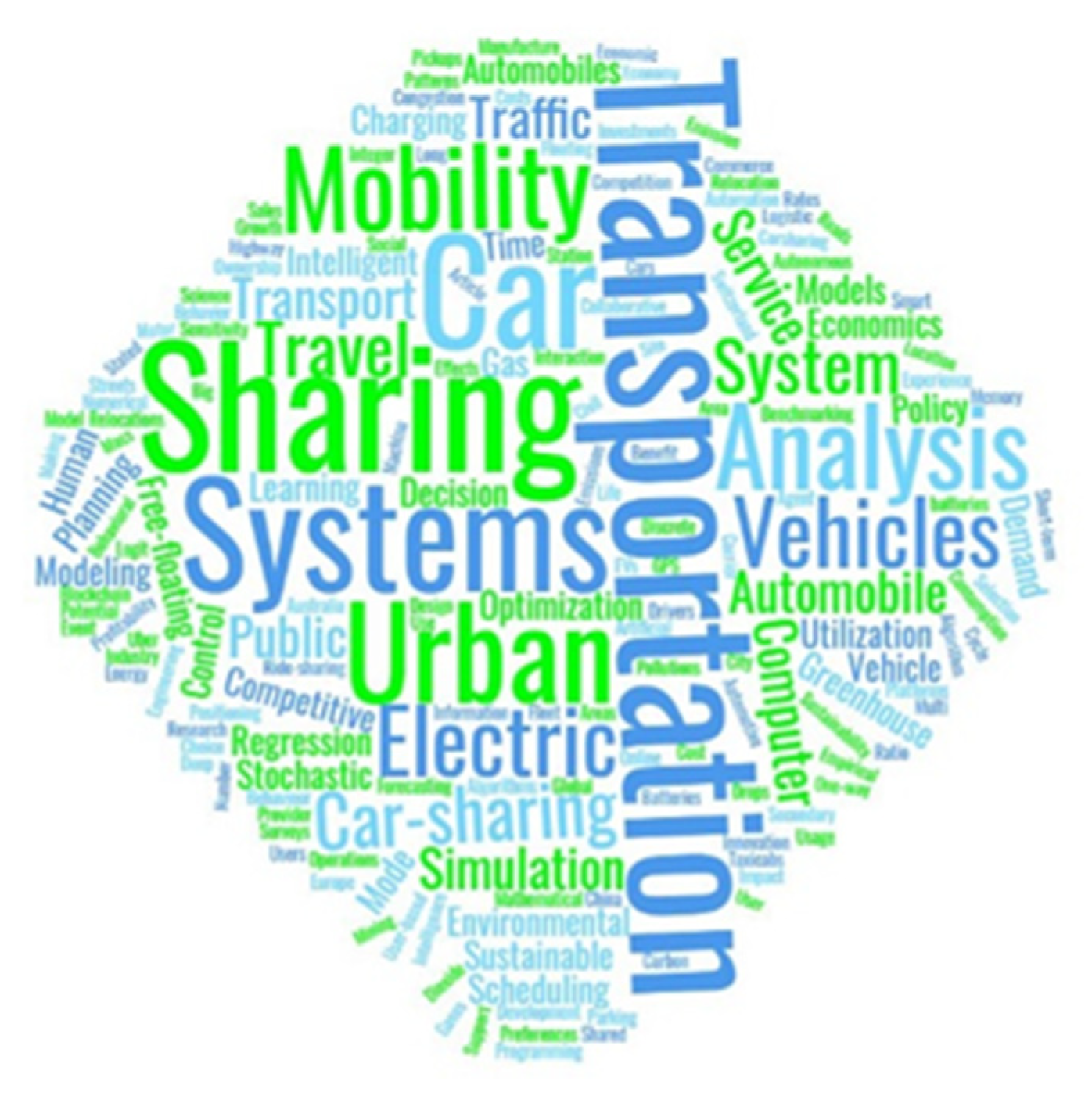
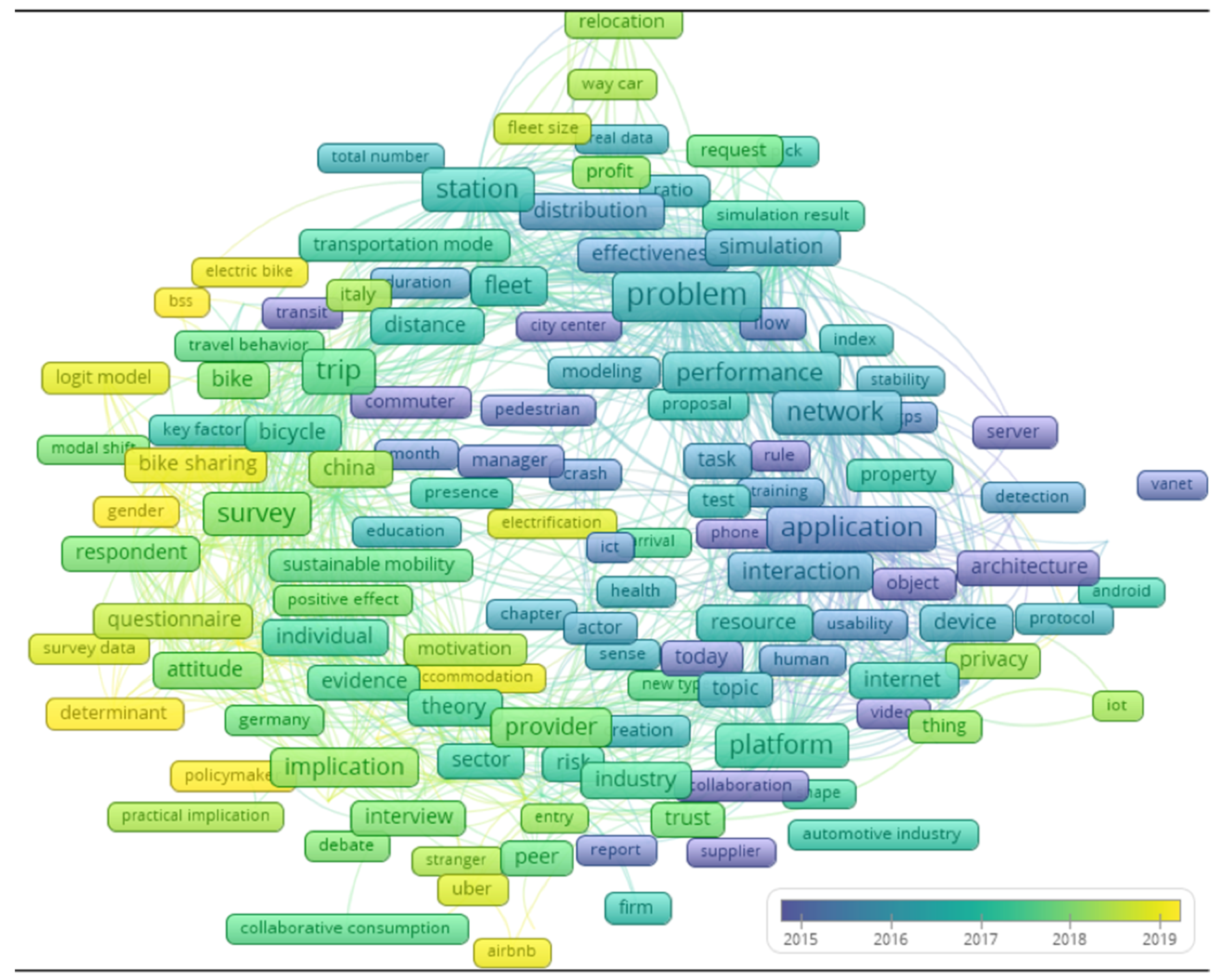
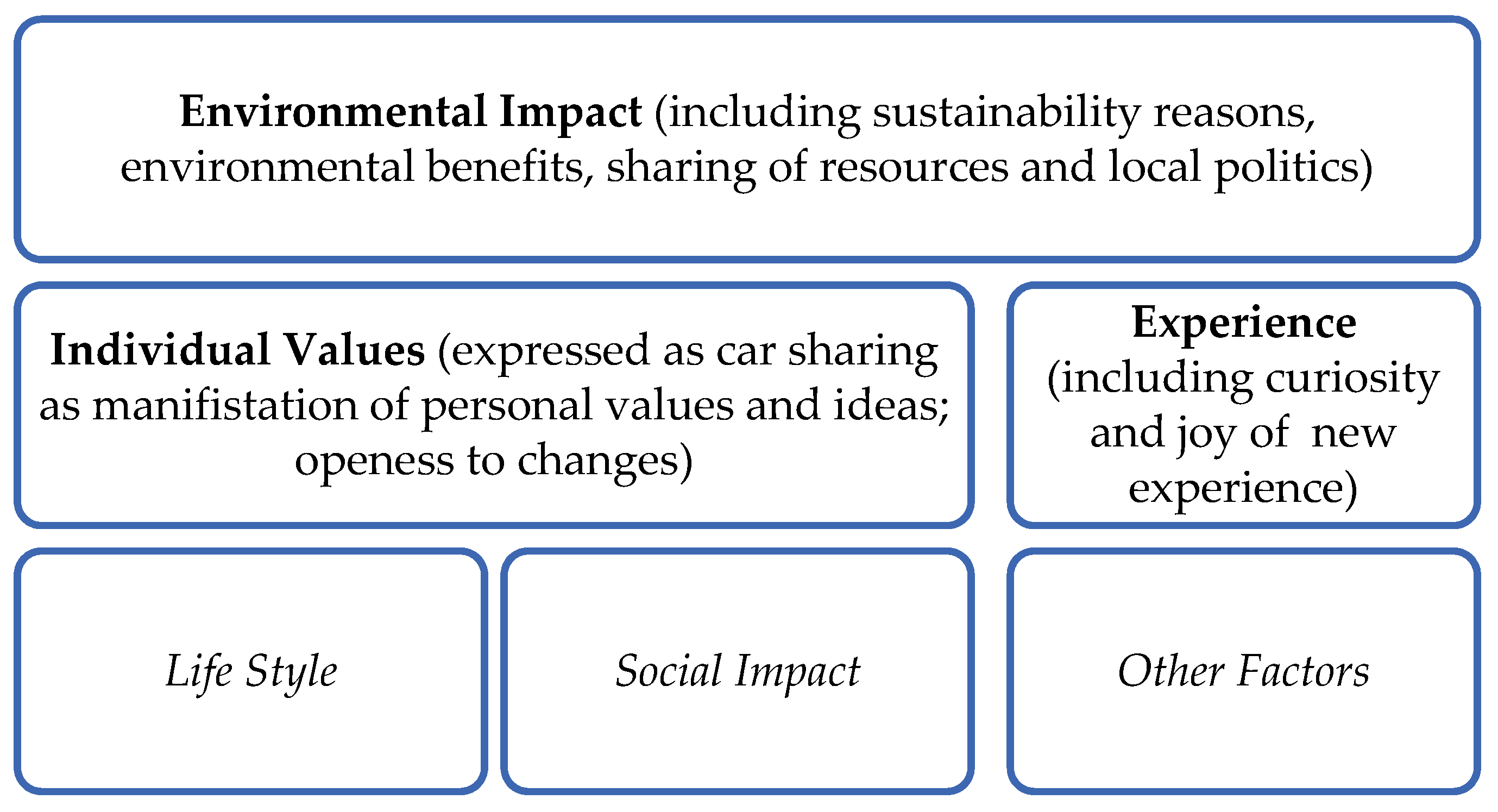
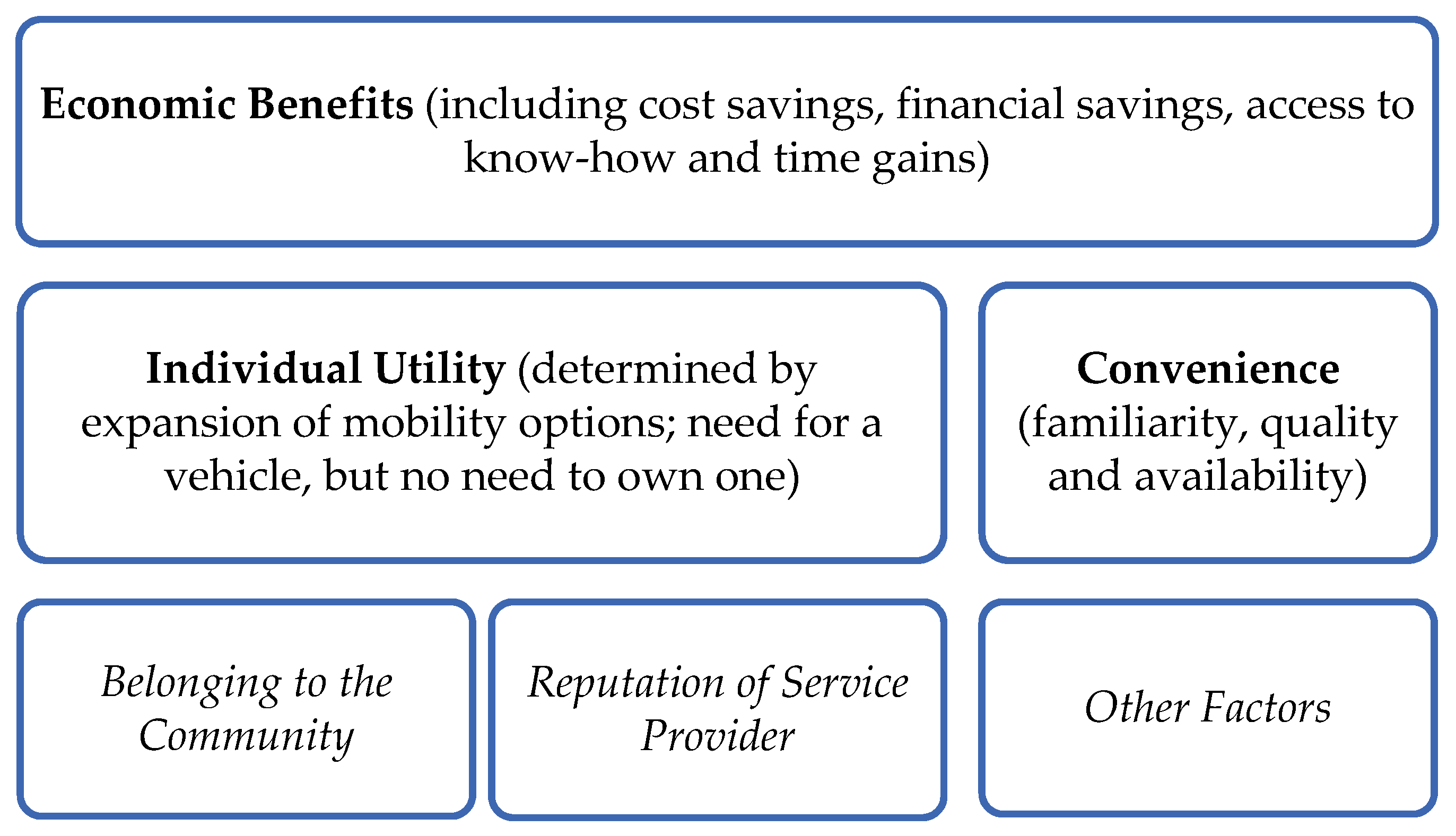
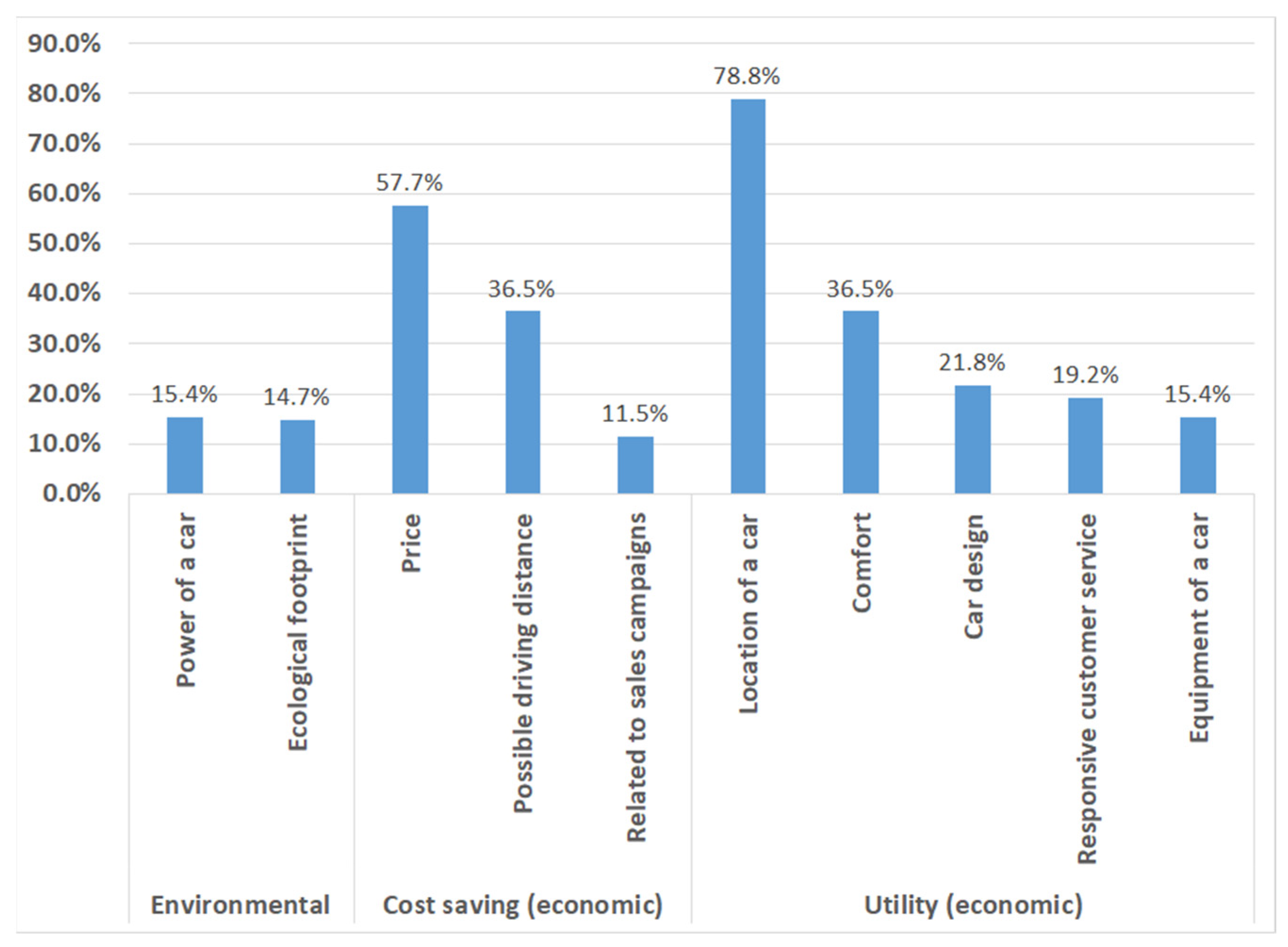
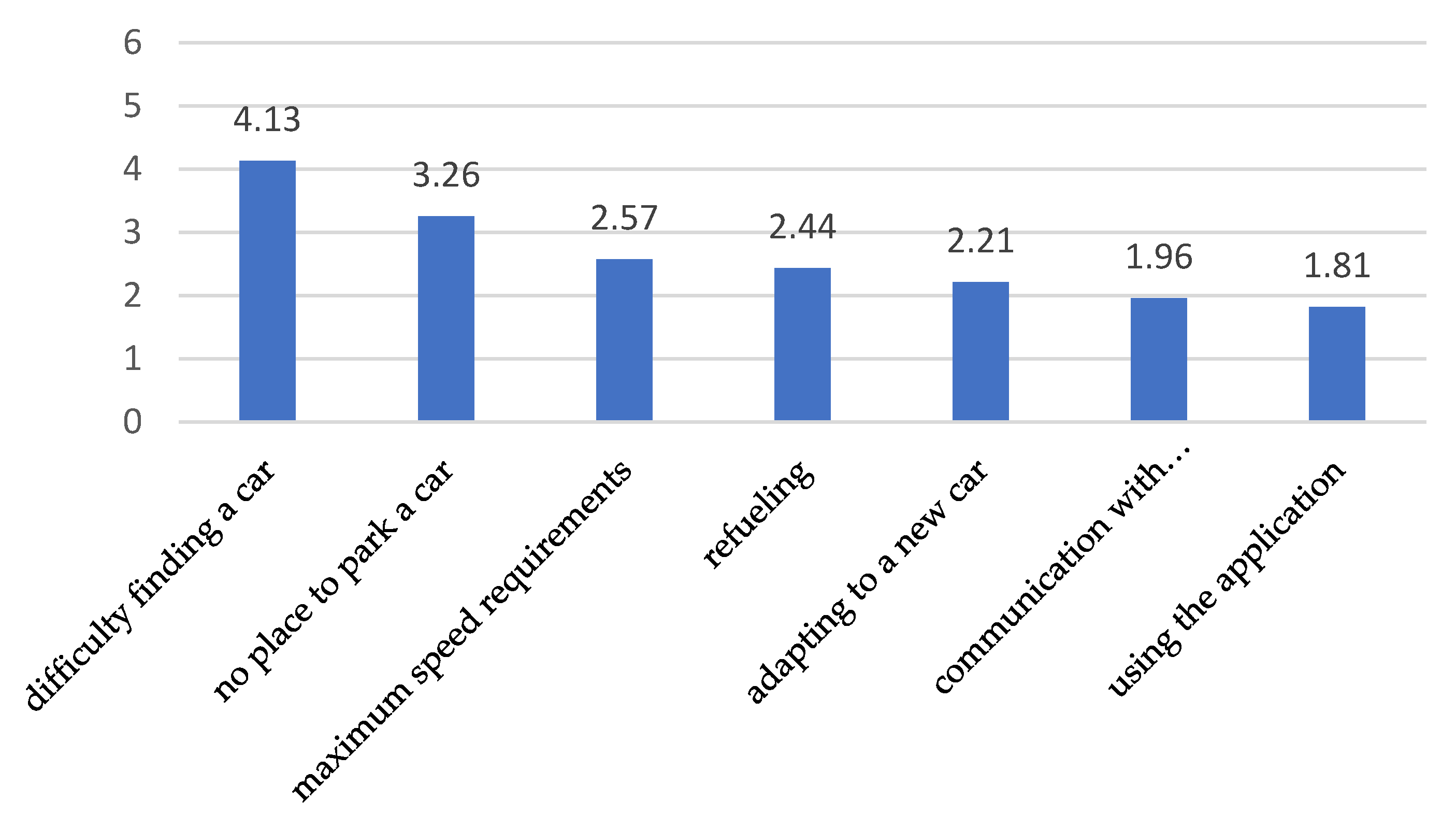
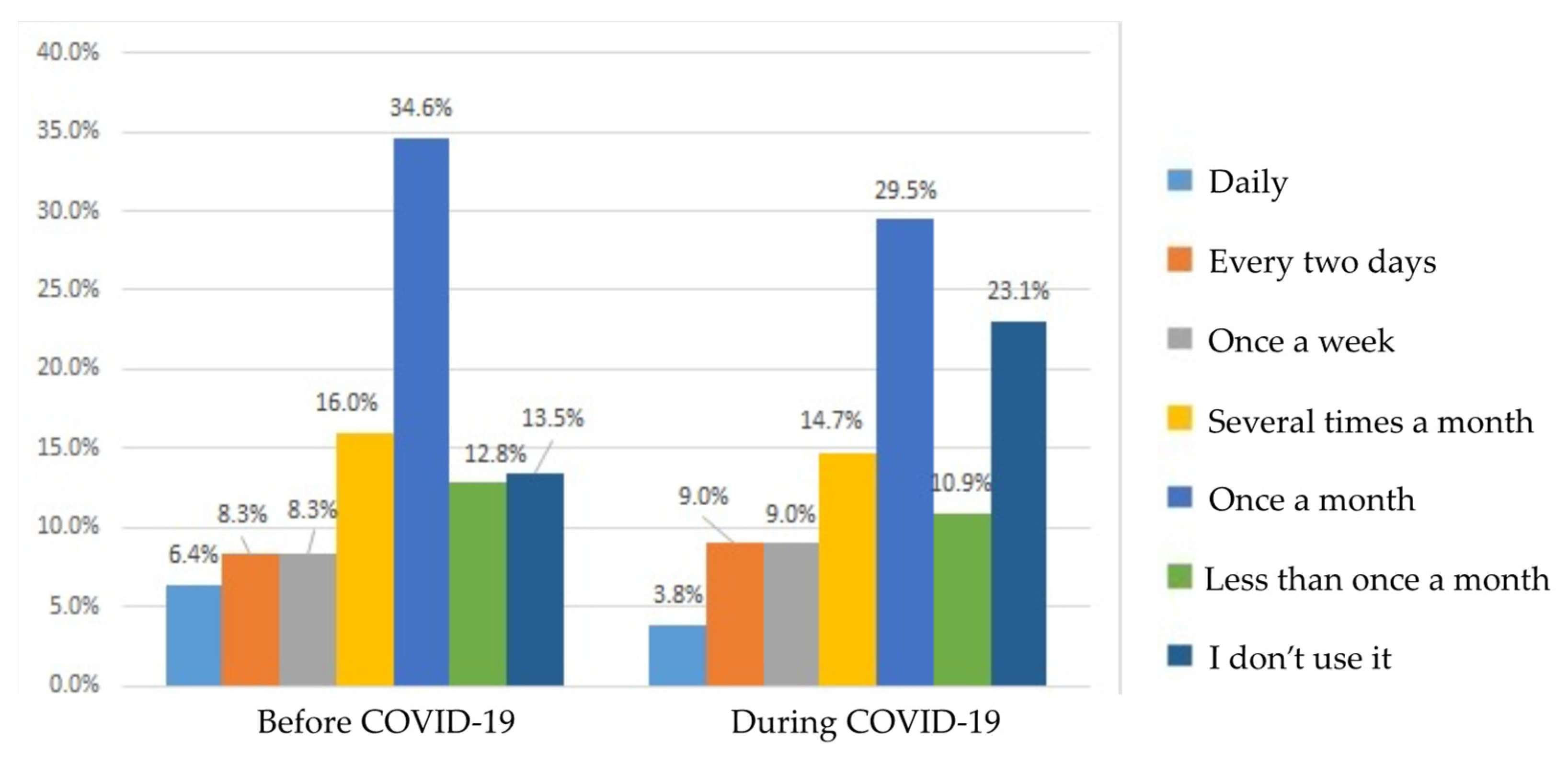
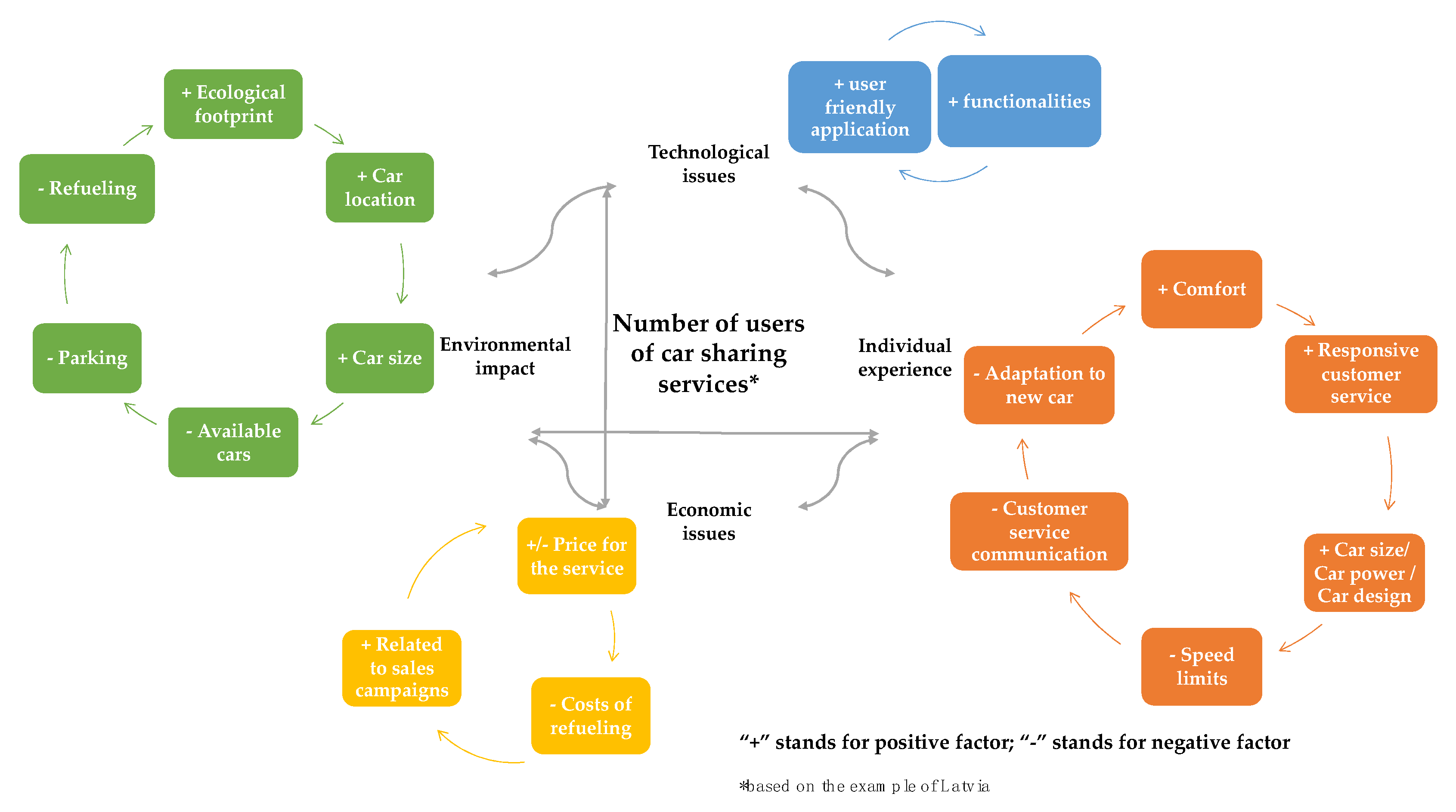
| Generation | Respondents | Percent (%) |
| X and older (42+) | 84 | 23.1 |
| Y (25–41) | 122 | 33.5 |
| Z (18–24) | 158 | 43.4 |
| Gender | Respondents | Percent (%) |
| Male | 153 | 42 |
| Female | 207 | 56.9 |
| Did not want to specify | 158 | 1.1 |
| Education | Respondents | Percent (%) |
| Higher | 227 | 62.4 |
| Secondary general or secondary professional | 137 | 37.6 |
| Generation | Users | Not Users | Total | |
|---|---|---|---|---|
| Generation X | respondents | 17 | 67 | 84 |
| % | 20.2 | 79.8 | 100 | |
| Generation Y | respondents | 53 | 69 | 122 |
| % | 43.4 | 56.6 | 100 | |
| Generation Z | respondents | 86 | 72 | 158 |
| % | 54.4 | 45.6 | 100 | |
| Total | respondents | 156 | 208 | 364 |
| % | 42.9 | 57.1 | 100 |
| Value | df | p | |
|---|---|---|---|
| Χ2 | 26,207 | 2 | <0.001 |
| N | 364 |
| Gender | Users | Not Users | Total | |
|---|---|---|---|---|
| Male | respondents | 84 | 69 | 153 |
| % | 54.9 | 45.1 | 100 | |
| Female | respondents | 71 | 136 | 207 |
| % | 34.3 | 65.7 | 100 | |
| Did not want to specify | respondents | 1 | 3 | 4 |
| % | 25.0 | 75.0 | 100 | |
| Total | respondents | 156 | 208 | 364 |
| % | 42.9 | 57.1 | 100 |
| Value | df | p | |
|---|---|---|---|
| Χ2 | 15.775 | 2 | <0.001 |
| N | 364 |
| Mean | Std. Deviation | |
|---|---|---|
| Location of a car | 5.513 | 0.891 |
| Price | 4.885 | 1.368 |
| Responsive customer service | 4.462 | 1.526 |
| Comfort | 4.071 | 1.296 |
| Car size | 3.513 | 1.526 |
| Power of a car | 3.212 | 1.455 |
| Car design | 3.192 | 1.451 |
| Ecological footprint | 3.16 | 1.568 |
| Related to sales campaigns | 2.929 | 1.745 |
Publisher’s Note: MDPI stays neutral with regard to jurisdictional claims in published maps and institutional affiliations. |
© 2021 by the authors. Licensee MDPI, Basel, Switzerland. This article is an open access article distributed under the terms and conditions of the Creative Commons Attribution (CC BY) license (https://creativecommons.org/licenses/by/4.0/).
Share and Cite
Mavlutova, I.; Kuzmina, J.; Uvarova, I.; Atstaja, D.; Lesinskis, K.; Mikelsone, E.; Brizga, J. Does Car Sharing Contribute to Urban Sustainability from User-Motivation Perspectives? Sustainability 2021, 13, 10588. https://doi.org/10.3390/su131910588
Mavlutova I, Kuzmina J, Uvarova I, Atstaja D, Lesinskis K, Mikelsone E, Brizga J. Does Car Sharing Contribute to Urban Sustainability from User-Motivation Perspectives? Sustainability. 2021; 13(19):10588. https://doi.org/10.3390/su131910588
Chicago/Turabian StyleMavlutova, Inese, Jekaterina Kuzmina, Inga Uvarova, Dzintra Atstaja, Kristaps Lesinskis, Elina Mikelsone, and Janis Brizga. 2021. "Does Car Sharing Contribute to Urban Sustainability from User-Motivation Perspectives?" Sustainability 13, no. 19: 10588. https://doi.org/10.3390/su131910588
APA StyleMavlutova, I., Kuzmina, J., Uvarova, I., Atstaja, D., Lesinskis, K., Mikelsone, E., & Brizga, J. (2021). Does Car Sharing Contribute to Urban Sustainability from User-Motivation Perspectives? Sustainability, 13(19), 10588. https://doi.org/10.3390/su131910588










